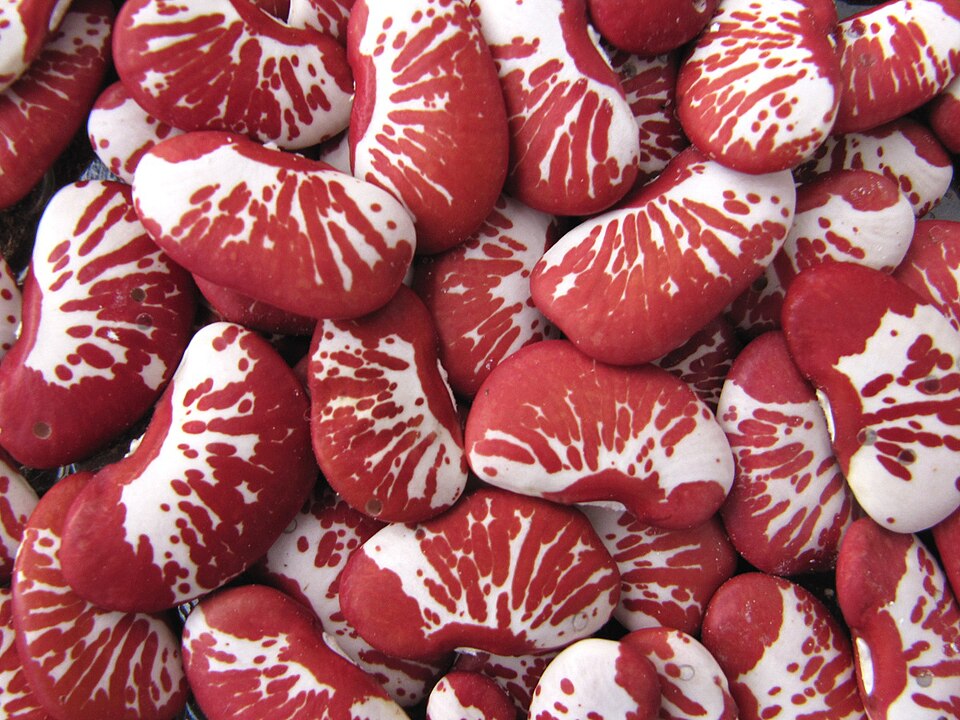Typical yield
1.5 t/ha
Varieties
3
Pest/Disease
5
Seasons
3
Profile
- Growth habit
- annual
- Lifecycle (days)
- 90–140
- Primary uses
- Pulse; fresh green or dry seed
- Pollination
- self
- Origin / distribution
- Americas; grown in tropics/subtropics incl. East Africa
Environment
Climate
Temp optimal
20–28 °C
Rain optimal
700–1200 mm/yr
Altitude
0–1800 m
Soil
pH optimal
6–7
Soil type
Well-drained loam/sandy loam
Farmer Guide
Row spacing
60 cm
Plant spacing
30 cm
Depth
3 cm
Seed rate
40 kg/ha
Nursery days
Planting: Sow after onset of rains in warm soil; inoculate with Rhizobium if available; stake climbing types.
Transplanting: Generally not transplanted.
Irrigation: Maintain moisture at flowering/pod fill; avoid prolonged wet soils.
Fertigation: Low N needed due to fixation; supply P and K; micronutrients as needed.
Pest scouting: Scout for bean fly, aphids, pod borers, anthracnose; rotate chemistries.
Pruning/Training: Stake/twine for pole types to reduce disease and ease harvest.
Harvest: Pick green pods regularly or dry seeds at full maturity; avoid shattering.
Postharvest: Dry seeds to ≤12% moisture; store cool & dry; control bruchids.
Nutrient Schedule
| # | Stage | DAP | Product | Rate | Targets (kg/ha) | Notes |
|---|---|---|---|---|---|---|
| 1 | Basal | 0 | NPK 17-17-17 (light) or DAP 18-46-0 (alt) | 60 kg/ha | N: —, P₂O₅: 20, K₂O: 20 | If using DAP, reduce additional N later |
| 2 | Topdress (veg) | 25 | CAN 26% N (optional) | 40 kg/ha | N: 10, P₂O₅: —, K₂O: — | Only if plants pale or poor nodulation |
Nutrient Requirements
| Nutrient | Stage | Amount | Unit |
|---|---|---|---|
| P₂O₅ | Basal | 25 | kg/ha |
| K₂O | Basal | 20 | kg/ha |
| N | Topdress | 10 | kg/ha |
| K₂O | Flowering | 20 | kg/ha |
Images

| Name | Country | Maturity | Traits |
|---|---|---|---|
| Local Lima | KE | 110 | Pole type |
| Local Lima (bush) | KE | 110 | Bush type; uniform pods |
| Pole Lima | KE | 130 | Climbing; extended harvest |
| Stage | Product | Rate (kg/ha) | Notes |
|---|---|---|---|
| Basal | NPK 17-17-17 | 60 | |
| Basal | DAP 18-46-0 | 60 | Band away from seed |
| Topdress (opt.) | CAN 26% N | 40 | Use based on leaf color/soil tests |
| Name | Type | Symptoms | Management |
|---|---|---|---|
| Bean fly | pest | Swollen stems; wilting seedlings | Seed dressing; early planting; ridge soil around stems |
| Aphids | pest | Leaf curl; honeydew/sooty mold | Conserve beneficials; spot sprays; control ants |
| Pod borer | pest | Bored pods/seeds | Timely picking; pheromone/light traps; selective insecticides |
| Anthracnose | disease | Dark lesions on pods/leaves | Clean seed; rotation; resistant varieties |
| Angular leaf spot | disease | Angular lesions on leaves | Sanitation; copper/protectants; airflow |
| System | Typical | Min | Max | Notes |
|---|---|---|---|---|
| rainfed | 1.2 | 0.5 | 2 | |
| rainfed smallholder | 1.2 | 0.5 | 2 | |
| irrigated/managed | 2 | 1.2 | 3 | Good fertility & pest control |
| Country | Region | Planting | Harvest |
|---|---|---|---|
| KE | Eastern | Oct–Nov | Jan–Mar |
| KE | Western | Mar–Apr | Jun–Aug |
| UG | Central | Mar–Apr | Jun–Jul |
| Country | Region | Suitability |
|---|---|---|
| KE | Eastern | Medium |
| KE | Western | High |
| UG | Central | High |
